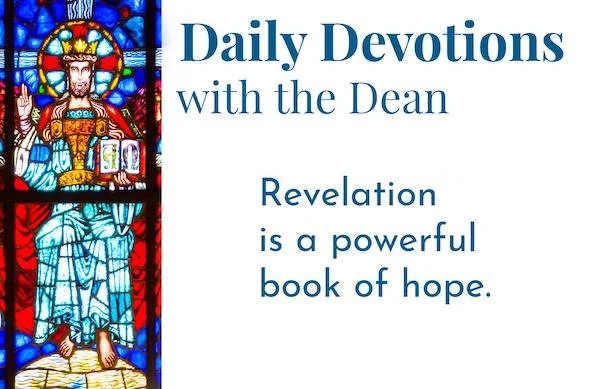Thursday • 11/2/2023 •
Thursday of the Twenty-second Week After Pentecost (Proper 25)
This morning’s Scriptures are: Psalm 50; Nehemiah 1:1–11; Revelation 5:11–6:11; Matthew 13:18–23
This morning’s Canticles are: following the OT reading, Canticle 8 (“The Song of Moses,” Exodus 15, BCP, p. 85); following the Epistle reading, Canticle 19 (“The Song of the Redeemed,” Revelation 15:3–4, BCP, p. 94)
Welcome to Daily Office Devotions, where every Monday through Friday we consider some aspect of that day’s Scripture readings, as given in the Book of Common Prayer. I’m Reggie Kidd, and I’m grateful to be with you. On this Thursday in the Season After Pentecost our readings come from Proper 25 of Year 1 in the Daily Office Lectionary.
“Well, that’s a matter of interpretation!” This phrase has shut down so many discussions about the Bible. In truth, the Bible does have to be interpreted. It’s important to acknowledge that fact, and then honestly to look for the best interpretation. That quest involves paying close attention to the text and listening to others who have interpreted the text as well (not to mention praying and listening to the Lord!).
When it comes to the Book of Revelation, I have found myself persuaded by those who see Revelation taking us up to final judgment seven different times, each time building in dramatic intensity. Final judgment, it seems to these interpreters and to me, takes place at 6:12–17; 7:9–17 (after the seven seals), at 11:15,18 (after the seven trumpets), at 14:14,15,18 (after the woman versus the dragon), at 16:17,20 (after the bowls, at 19:11–21 (after Babylon’s fall), and at 20:9b–15 (after Satan’s last campaign).
Image: Detail, stained glass, Cathedral Church of St. Luke, Orlando, Florida
On several occasions, those cycles begin with a look back on Jesus’s earthly ministry and his inaugural victory over sin and Satan and death. That’s how I understand, for instance, Revelation 12’s description of the child born to the woman and taken up to heaven. It’s also how I understand Revelation 20’s description of Satan being bound (which is what had enabled Jesus to “cast out Satan” in his exorcisms, according to Matthew 12:26–29; Mark 3:23–27. In the parallel passage, Luke says Jesus “overcomes”).
Though it’s difficult to be dogmatic about it, I think that today’s passage introducing the seven seals also begins with a look back on the earthly ministry of Christ. The “first horseman” has a bow and a crown and comes “conquering and to conquer.” The word is nikein, and is more generally translated “to overcome,” and its connotations in John’s writings are positive more often than not.1 Jesus says, “I have overcome the world” (John 16:33), and his believers are urged to “overcome” (Revelation 2:7,11,17,26; 3:5,12,21; 15:2; 21:7). The Lion of Judah who was slain as a lamb has “overcome” (Revelation 5:5). His initial and inaugural victory over sin and death will culminate in a final “overcoming” of all of God’s and his people’s enemies (Revelation 17:14).
The horsemen that come with the second, third, and fourth seals depict Satanic pushback—war, famine, and death. During the span of time between Christ’s first coming and his second coming, we will be beset by much misery. Thus, with the fifth seal, we find ourselves crying out “How long?” (Revelation 6:10). “How long” will war, famine, and death impact our lives? “How long” until we experience relief?
Then there is this amazing response: “…a little longer, until the full number would be complete” (Revelation 6:11). In the immediate context, martyrs are being told that the full number of martyrs must be complete—which doesn’t sound like great news. However, the panorama opens out to show what “the full number” means at a deeper level. For, following the sixth seal just before final judgment (Friday’s reading of the end of Revelation 6 and the beginning of Revelation 7), we view what the true “full number” that the “little longer” of our wait will have produced: a completed Israel (the symbolic 144,000 Jews of Revelation 7:4–8) and an innumerable host of Gentiles (Revelation 7:9–17). It’s what Paul calls “the fullness of Jews” and “the fullness of Gentiles” (Romans 11:12,25).
The point of the whole book of Revelation is nicely summed up in its first seven chapters. We begin with a vision of the resplendent Christ who loves us and has set us free from our sins by his blood (Revelation 1). We see in Revelation 2 and 3 that he cares intimately for his churches that struggle with persecution from without, and error and faithlessness within. Revelation 4 reminds us that the Creator has not given up on his creation, and Revelation 5 assures us that all of history unfolds in the hands of the victorious Lion/Lamb.
Here in Revelation 6–7’s first cycle of judgment we are assured that our living between the time of Christ’s initial “overcoming” in his earthly ministry, his death, and resurrection for us—between that time and his return in final victory—we will live with a dual reality. Believers, no less than unbelievers, will live with war, famine, and death. However, during this symbolically “a little longer,” God will be sovereignly at work through the witness of his martyrs and faithful believers to bring to himself the Israel of his election and the nations who stream in to receive the promises.
Revelation is a powerful book of hope, a book that urges us to look with compassion on our neighbors who know only the gloom of war, famine, and death. Revelation calls us to invite them to join us in looking up to the Creator, to reach out to the Redeemer, and to allow themselves to be added to the great host of those who will one day greet with joy Christ’s coming in final victory.
Be blessed this day,
Reggie Kidd+



